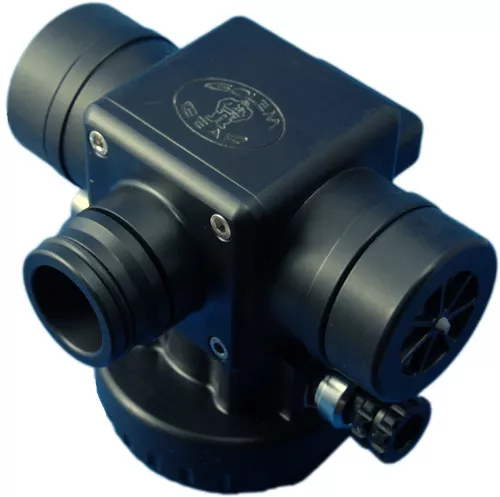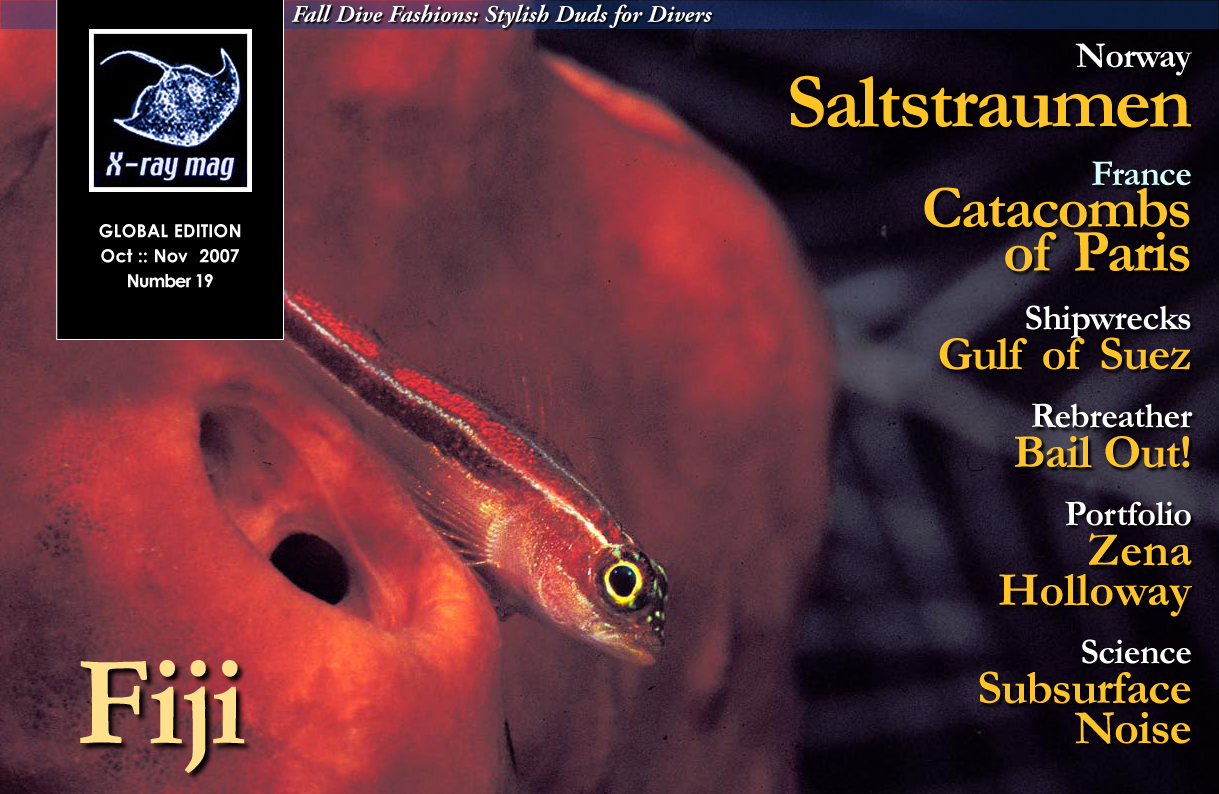Bailing out to Open Circuit is like falling in the snow when you are learning to ski. It’s a solution when facing a problem—not always the most elegant solution, but always the easiest one, and most of the time, the most efficient one. But Open Circuit bail-out is actually much more than simply going off the loop and breathing from another second stage. There are lots of possibilities.
Contributed by
Sanity Breaths
When dealing with most of the problems that could occur with a rebreather—equipment failure, physiological problem, etc.—one of the first reactions should be to do a diluent flush to make sure you breathe a safe gas for the few seconds you’ll need to switch to OC and take some sanity breaths from a known mix. Four or five breaths should help most of the divers experiencing any kind of symptoms to quickly regaining their ability to think properly and to react in the most efficient way.
In case of hyperoxia, hypoxia, mild hypercapnia, or any mechanical or electronical problem, a good diluent flush followed by some sanity breaths can help. Even if this doesn’t help, most of the time it doesn’t do any harm (if the mix is safe to breathe at that depth), apart from depleting the stock of gas available. These sanity breaths can be done in different ways:
BOV (Bail-out Valve)
That’s generally the easiest and fastest way. There is no need to remove the mouthpiece, so no stress. The BOV is already in the mouth, so no delay and no risk of drowning or panic. Therefore, a BOV is extremely useful, even required when diving with a Full-Face Mask. Some rebreathers come with a BOV fitted (Kiss, RB80, Cis-Lunar, etc), or it can be purchased separately (Golem Gear, Nemo, etc). The BOV is normally fitted to the on-board diluent but with a quick-connect, all your dreams can be fulfilled…
Open Loop technique
Still no need to go off the loop. The idea is to use the ADV as a kind of “manual 2nd stage”—obviously less convenient than a BOV, especially in case of a flooded loop. However, it’s one of the fastest options and can be so easily done that it should be one of the first skills to be taught to any CCR novice.
Standard 2nd stage
Fitted on a sling tank, it provides the diver with a sufficient and known source of gas. However, lots of rebreather divers simply store the complete regulator on the side of the sling tank. This configuration obviously requires more time than if the 2nd stage is stored on a shock cord loop around the neck. Remember, one of the goals of the sanity breaths is to quickly go off the loop to be able to safely breathe and think about the safest way to fix a problem.
Looking for a few seconds for a second stage that is trapped somewhere (or even worse, loose) is not the best choice. Opening the tank valve also takes some time. If the 2nd stage is stored around the neck, the tank valve can be left open and any leak or free flow will then be easily spotted.
Combined regulator/2nd stage
This is another option fitted on some rebreathers like the Inspiration and the Evolution. Some rebreather divers don’t like them as it might be difficult to breathe from them at depth. Other divers like the convenience and store them around the neck. One of the problems with hypercapnia is the often-associated uncontrolled urge to breath. Closing and removing a DSV, then clearing a mouthpiece before being able to breathe is sometimes next to impossible. Because of the risk of water egress in the airway, a BOV is a convenient and safe way to gain control on the breathing pattern for a short period of time. It can only be a temporary measure before switching to a bigger stock of gas (off-board diluent/bail-out tank).
Open Circuit Bail-out
As every rebreather diver (either SCR or CCR) learns during their basic rebreather diver course, having enough open circuit gas to safely ascend to the surface is not an option. It’s a requirement.
Why go the OC way when you have so many other options with a CCR? Because it’s safe! The rule is: if you don’t know where the problem comes from, if you don’t know how to fix the problem, or if you simply don’t know if the mix in the loop is breathable, stay on Open Circuit.
Even if most of the problems can be fixed at the bottom on a CCR, there are three circumstances where there is absolutely no other reasonable alternative than bailing out on Open Circuit:
- Total Loop Flooding. If divers properly check their units before the dive, there should never be any Total Loop flood. Unfortunately, it happens from time to time, mainly because of a user error (lost mouthpiece, DSV removed while still open, lack of pre-dive positive and negative pressure test, etc).
- Severe Hypercapnia. In case of scrubber breakthrough, the signs and symptoms of hypercapnia might be so severe that chances to recover from the CO2 hit become minimal. Keeping on breathing from the loop (even on an SCR mode) makes these chances even smaller. Ascending (reducing the ambient pressure and the pCO2), stopping any exertion (no CO2 production) and breathing from an OC regulator (no CO2 build-up) could be the best solution.
- Personal choice. It’s like the rule about aborting a dive at any time for any reason. When one doesn’t feel comfortable on the loop, there is no shame in bailing-out. It helps to get the stress level down and avoid any further problem.
In any case, the procedure should always be the same, to keep the thinking process as limited as possible. When your brain becomes as small as a peanut and as primitive as an action movie hero, you need simple steps to follow:
- Start with a few Sanity Breaths. With a BOV, it’s extremely easy. Take a few long and slow breaths to clear up your mind and relax somehow. This is one of the reasons why many rebreather divers prefer to always have the same on- and off-board diluent/bottom mixes: they don’t mix up their decompression with multiple diluents and bottom bail-out gas.
- Try to identify the problem and its cause. Different tools are available for that (from the handsets to the SPGs, the HUD, audible or visual alarms, your symptoms, etc).
- If the problem can be fixed, do it and come back to the loop when—and only if—it’s safe to breathe from.
- If the problem can’t be fixed, it’s the right time to prepare the bail-out ascent. Don’t drain your on-board gas as most of the time, it’s also the gas you use to inflate your wing (and sometimes your dry suit); in case of emergency, you might need to be positively buoyant at the surface. Prepare for a 3-step ascent:
- Switch to the off-board regulator. Many rebreather divers prefer to always have this tank valve cracked open (easy to shut off in case of free flow, quicker to breathe in case of emergency).
- Communicate with the team mates and check for the dive parameters (depth, time, decompression, navigation)
- Control buoyancy. It’s often a tricky part, as the loop will expand during the ascent.
The key to success is
- Slow ascent,
- OPV fully open and
- Practise.
Apart from Buoyancy control, there shouldn’t be any stress involved in this kind of ascent, as long as one has enough gas to complete the ascent.
It might be wise to plan for the worst-case scenario—like having the problem at the deepest depth or the furthest point of penetration while being separated from the team. And make sure you have enough gas with at least a 30m/min SAC rate.
Different BOVs available
The Bail-Out Valve (BOV) is not a new idea. Unfortunately, there are not so many rebreathers on the market that incorporate this extremely useful feature as standard. Switching to OC without removing the mouthpiece sounds really interesting for most of the rebreather divers. Therefore, some BOVs are available, most of them with adapters to fit in all the major rebreathers currently available.
The necessary features are:
► Small and light. You don’t want to have a small anvil hanging on your mouth. It would be at least uncomfortable, even dangerous, as it will increase the risk of losing it and flooding the loop.
► Easy to switch. Some BOVs are very stiff and you need the help of a team of weightlifters to operate the lever. Not the best solution when your loop is full of water and your lungs are empty after a few minutes.
► Easy to breathe at depth. When you need to breathe OC, it’s because you NEED to breathe! Only high performance 2nd stage should be used in BOVs. Even if your diluent is easier to breathe because of its Helium content, the fact is that one needs a lot of gas when switching to Open Circuit. A hard-to-breathe-at-depth BOV will just make everything worse and increase the stress level.
► Not free flowing. That’s where manufacturers speak about compromise. How could an easy-to-breathe 2nd stage not be prone to free flow i.e. at the surface when submerging, or when scootering? One answer is the adjustable knob, designed to avoid losing the precious and limited gas at the beginning of the dive. It should be set “Hard” before jumping into the water, then loosened up during the bottom phase, just in case…
► Air and watertight. That’s where some of the BOVs on the market have a lot of problems. I personally experienced a lot of leaks and failures to hold negative pressure with two BOVs that come standard with some popular CCRs. It’s a life-support equipment so proper designing and machining are of the utmost importance.
I had the opportunity to try the following BOVs: KISS, Golem Gear and v4tec. I also extensively studied these other models: Nemo, Kirby-Morgan (NATO pod) and Cis-Lunar.
I selected the Golem Gear for my Megalodon CCR, as I found it a reliable and robust piece of equipment that actually meets all the requirements listed above. The design is simple, and the performance at depth more than satisfying. It comes in two flavours that allow it to fit on most of the rebreathers. The lever is a little bit hard to operate when it’s brand new but everything becomes easier after a couple of dives. It’s also very easy to service and maintain, and a little bit of grease eases up the lever without contributing to any leak. And the LP hose comes from the left hand side, more convenient for my tank configuration.
When it comes to safety for CCR divers, bail-out tanks are often compared to an ejection seat on a very sophisticated plane. You have a very expensive machine that fails. You need a very simple solution that always works!
A proper Bail-out Valve is an easy and quick way to breathe Open Circuit. Who would say that it’s not of the utmost importance? ■






























